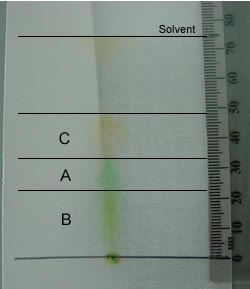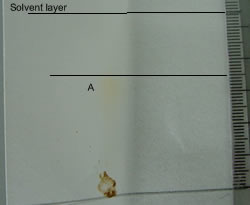The pigments of a green leaf, from an Elm tree, were processed using Thin Film Chromatography and the chromatogram shown on the right.
Pigment "A" represents
chlorophyll A while Pigment "B" represents chlorophyll B.
Pigment "C" represents xanthophyll
Calculate the Rf value of each of the pigments.
Click on the picture to see a larger image.

Two leaves from an ornamental
vine were taken and the pigments extracted and processed using Thin Film
Chromatography. A green leaf and a red leaf were selected. The chromatogram
is shown on the right with the green leaf on the right and the red leaf
on the left.
Click on the picture
to see a larger image of the chromatogram.
Assuming the solvent
has risen 8.6 cm up the chromatography paper:
-calculate the Rf value of pigment A.
-calculate the Rf value of pigment B
Is this pigment chlorophyll B?
Is pigment "B" also found in the Elm tree?

A dried Elm leaf was processed and the chromatogram shown on the right.
How many pigments are visible?
Identify this pigment.
Click on the picture to see a larger image.

Do red leaves contain the green pigment chlorophyll?
Are the pigments found in red leaves also present in green leaves?
Do different plants have different types of chlorophyll?
Does a leaf that has been kept in the dark quickly lose its chlorophyll? If so how many days does it take?
Ask your teacher for more ideas and how to set up a scientific investigation.